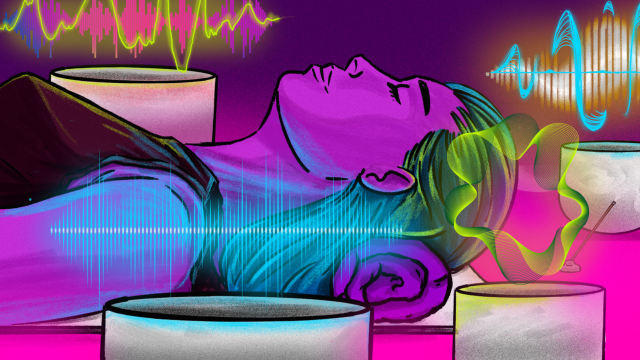After months and months of nonstop bad news, we’re all feeling run-down and looking for ways to destress and centre ourselves. Have you considered meditation? Sound baths can help you stay focused during meditation — and you can even do them at home. Here’s how.
Start by embracing basic meditation
“Meditation is simply a practice to bring you within and be present in the moment,” says Tara Atwood, a New England-based sound bath and meditation expert. “This is often quite difficult, as our mind wanders.”
Let’s get real: It’s hard to stay present in the moment when the moment is so fraught. From the pandemic to global warming to domestic and global politics, everything seems to be a mess right now, and it can feel downright impossible to tear your thoughts away from all that dread. You need to, though, for your own well-being. You have to find joy and self-fulfilment. And for some, meditation really is the key to that.
If sound baths sound intriguing to you, you should first try some simple meditation. You don’t need to go full-blown into it and start showing up at your local meditation centre every day — YouTube is full of simple, guided meditations you can do anywhere and at any time, and experts like Atwood have their own available, too.
At its most basic level, meditation is about focusing on mindfulness, paying attention to each breath that goes into and out of your body, and noticing where your mind wanders as you do that. It doesn’t have to be intimidating — just close your eyes and take a few moments to focus on your breathing. Atwood points to lower blood pressure, reduced anxiety levels and tension-related pain, and an increase in happiness and creativity as some of the many benefits of meditating.
OK, so what’s a sound bath?
Sound baths and sound therapy are used in meditation to help you focus and stay present, Atwood explains: “With each sound, tone, and note, you are brought back to the moment.”
“Sound healing therapy uses aspects of sound and music to improve physical and emotional health and well-being,” she says. “Rich, audible tones and invisible frequencies are heard and felt, and our bodies naturally resonate with the frequencies emitted into the space, restoring normal vibratory frequencies from out-of-harmony parts of the body, mind, and soul, while encouraging a deep state of relaxation and healing. The frequencies of sound and audible tones have deep effects on our breath, blood flow, cellular movement, biorhythms, thoughts, and our brain waves.”
Atwood uses ancient Tibetan singing bowls and pure quartz crystal alchemy bowls for her sound baths, but you can start a little smaller. She said you can even use your voice to hum and create vibrations.
Check out offerings online, too: Amazon sells singing bowls, as do independent specialty stores. Some bowls go for as little as about $US35 ($49), so you don’t need to break the bank — and cause yourself financial stress — in the pursuit of lower anxiety.
Once you get your singing bowl or vessel, rub or strike it (usually with a tool that is included) to produce the desired vibrations.
What to expect from sound baths
We live in a chaotic, rarely mindful era, so you might have a hard time getting into the zone for this. Don’t worry if your mind wanders a lot at first. Keep at it and work hard to stay focused on your breathing and body.
“A sound bath (both virtually and in-person) requires you to be in a silent and safe place that allows you to fully relax and be present without distractions,” says Atwood, who recommends finding a safe and quiet place, turning off your phone, making sure the temperature of the space is moderate, and lying on the floor in a comfortable position with pillows.
If you’re doing a guided meditation, she adds, “you will be invited to first be present in the space while focusing on your breathing and breath. You may be asked to do a body scan to connect with your physical body and help focus your mind on the here and now.” Fully relax your body and make sure your hands and feet aren’t touching anything.
Again, don’t worry about going to in-person meditation centres if you don’t want to — or if these pandemic times have you freaked out about doing some deep breathing surrounded by other people.
“It’s quite fine to participate in virtual sound baths,” Atwood says. “In fact, before the pandemic, this is how I personally practiced, as I cannot play for myself live, and instead I would simply listen on a speaker to myself play a previously recorded session. Having experienced sound baths in person in India daily during training, and now virtually at home, I have found that the experience is essentially the same and results in similar and comparable results.”
If you choose to go that route, record your sound bowls and then listen to your recordings using headphones while you meditate.
Finally, don’t worry about somehow getting this “wrong.” The goal here is not to worry and to instead embrace some peacefulness. If you feel yourself relaxing and connecting to your mind and body, you’re doing it right. Case closed.

Leave a Reply
You must be logged in to post a comment.